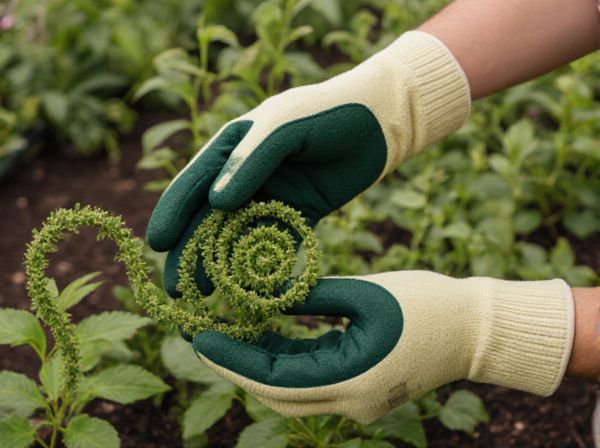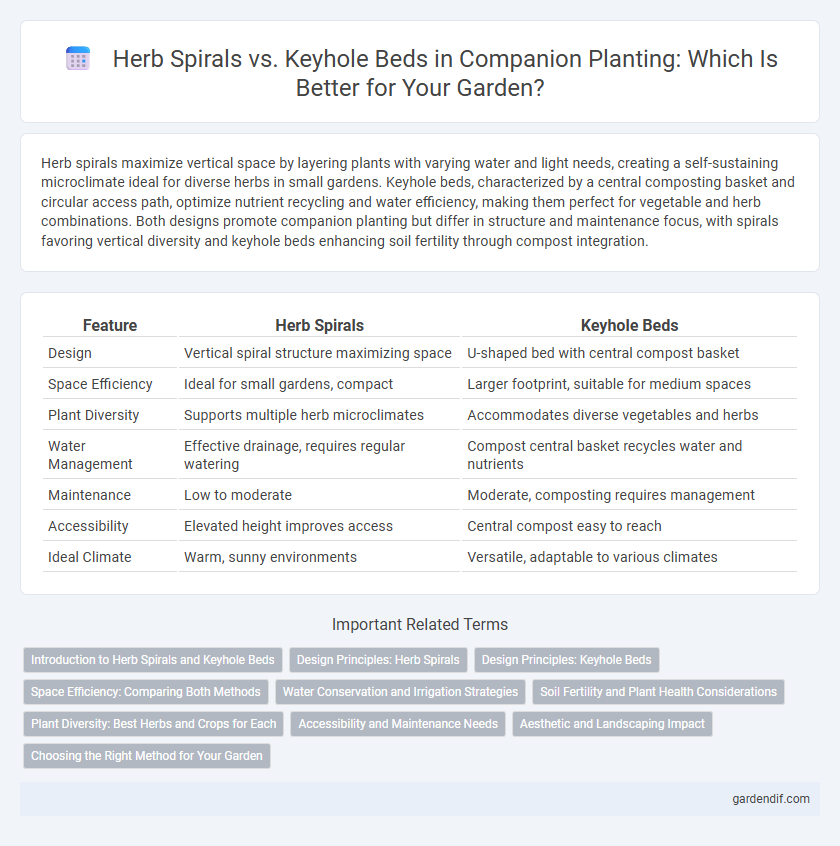
Herb spirals vs Keyhole beds Illustration
Herb spirals maximize vertical space by layering plants with varying water and light needs, creating a self-sustaining microclimate ideal for diverse herbs in small gardens. Keyhole beds, characterized by a central composting basket and circular access path, optimize nutrient recycling and water efficiency, making them perfect for vegetable and herb combinations. Both designs promote companion planting but differ in structure and maintenance focus, with spirals favoring vertical diversity and keyhole beds enhancing soil fertility through compost integration.
Table of Comparison
| Feature | Herb Spirals | Keyhole Beds |
|---|---|---|
| Design | Vertical spiral structure maximizing space | U-shaped bed with central compost basket |
| Space Efficiency | Ideal for small gardens, compact | Larger footprint, suitable for medium spaces |
| Plant Diversity | Supports multiple herb microclimates | Accommodates diverse vegetables and herbs |
| Water Management | Effective drainage, requires regular watering | Compost central basket recycles water and nutrients |
| Maintenance | Low to moderate | Moderate, composting requires management |
| Accessibility | Elevated height improves access | Central compost easy to reach |
| Ideal Climate | Warm, sunny environments | Versatile, adaptable to various climates |
Introduction to Herb Spirals and Keyhole Beds
Herb spirals are vertical garden structures that maximize space by layering herbs in a spiral design, promoting microclimates for diverse plant growth. Keyhole beds feature a circular planting area with a central composting basket, optimizing nutrient recycling and water retention for sustainable gardening. Both methods enhance herb cultivation by improving soil health and accessibility in compact garden spaces.
Design Principles: Herb Spirals
Herb spirals maximize vertical space with a spiral design that creates diverse microclimates, allowing for varied plant needs in a compact footprint. Their concentric layers promote efficient water drainage and sunlight exposure, fostering healthy growth for herbs requiring different moisture levels. This design supports biodiversity and easy access, making it a sustainable choice for intensive herb planting.
Design Principles: Keyhole Beds
Keyhole beds focus on maximizing space efficiency with a central composting basket that enriches surrounding plants, promoting nutrient recycling and moisture retention. Their design principles emphasize accessibility by allowing gardeners to reach all areas without stepping on soil, reducing compaction and improving soil health. This layout supports diverse planting and enhances microclimates, making it ideal for companion planting and sustainable gardening.
Space Efficiency: Comparing Both Methods
Herb spirals maximize vertical space by layering plants in a compact, tiered design that supports diverse growth zones within a small footprint. Keyhole beds optimize space with a circular layout and central composting area, allowing easy access and nutrient recycling in tighter garden plots. Both methods enhance space efficiency, but herb spirals excel in vertical layering, while keyhole beds prioritize accessibility and soil health.
Water Conservation and Irrigation Strategies
Herb spirals utilize vertical design to retain moisture efficiently, reducing overall water usage by directing irrigation to plants with varying water needs. Keyhole beds incorporate a central composting basket that naturally moistens surrounding soil, enhancing water retention through organic matter integration. Both structures optimize water conservation but herb spirals are particularly effective in minimizing irrigation runoff due to their tiered layout.
Soil Fertility and Plant Health Considerations
Herb spirals enhance soil fertility by creating microclimates that support diverse soil organisms and improve nutrient cycling, promoting robust plant health. Keyhole beds optimize soil fertility through central composting areas, allowing nutrients to be efficiently distributed to surrounding plants, which reduces soil degradation. Both designs support healthy plant growth but differ in their approach to nutrient management, with herb spirals favoring vertical diversity and keyhole beds emphasizing centralized organic matter integration.
Plant Diversity: Best Herbs and Crops for Each
Herb spirals maximize vertical space, allowing a diverse range of herbs like thyme, rosemary, and basil to thrive in layered microclimates, from sun-loving plants at the top to moisture-preferring ones near the base. Keyhole beds offer extensive planting space suitable for a broader variety of crops, including leafy greens, root vegetables, and companion herbs such as mint and oregano, promoting biodiversity and nutrient sharing. Choosing between herb spirals and keyhole beds depends on the desired plant variety and garden space efficiency.
Accessibility and Maintenance Needs
Herb spirals offer vertical gardening that maximizes space and allows easy access to herbs at different heights, reducing bending and stretching during maintenance. Keyhole beds provide a compact layout with central composting space, making it simple to nourish plants but may require more reaching over the bed edges for upkeep. Both designs enhance accessibility, but herb spirals tend to be easier to maintain for users with limited mobility.
Aesthetic and Landscaping Impact
Herb spirals create a visually striking vertical garden that maximizes space and adds a natural focal point to landscaping, combining functionality with organic aesthetics. Keyhole beds offer a symmetrical, geometric form that integrates seamlessly into structured garden designs, promoting a tidy and accessible layout. Both designs enhance garden beauty but cater to different landscaping styles--spirals evoke rustic charm while keyhole beds emphasize order and balance.
Choosing the Right Method for Your Garden
Herb spirals maximize vertical space and create diverse microclimates, ideal for growing a variety of herbs in compact gardens. Keyhole beds offer easy access to a central composting area, enhancing soil fertility and water retention, making them perfect for sustainable vegetable and herb cultivation. Select herb spirals for space efficiency and aesthetic appeal, while keyhole beds suit gardeners prioritizing ergonomics and organic soil enrichment.
Herb spirals vs Keyhole beds Infographic

 gardendif.com
gardendif.com